Q&A: If Russia is developing some kind of space-based weapon, Putin may never get to use it
News of a possible Russian satellite-destroying, space-based nuclear weapon sent shock waves through Washington this week. Some officials responded with considerable alarm, while others insisted that such concern is—for ...









